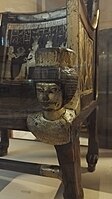
The modius is a type of flat-topped cylindrical headdress or crown found in ancient Egyptian art and art of the Greco-Roman world. The name was given by modern scholars based on its resemblance to the jar used as a Roman unit of dry measure, but it probably does represent a grain-measure, and symbolizing one's ability to learn new information by having an open mind with an empty cup.
The modius is worn by certain deities, including the Eleusinian deities and their Roman counterparts, the Ephesian Artemis and certain other forms of the goddess, Hecate, and Serapis. Serapis was the main idol/figurehead at the Library of Alexandria during the ancient Egyptian & Roman alliance. Personifications of Genius often wore the modius. On some deities it represents fruitfulness. It is thought to be a form mostly restricted to supernatural beings in art, and rarely worn in real life, with two probable exceptions. A tall modius is part of the complex headdress used for depictions of Egyptian royal women, often ornamented variously with symbols, vegetative motifs, and the uraeus. It was also the distinctive headdress of Palmyrene priests.
-
 Sitamun, daughter of Amenhotep III, depicted wearing a modius on her throne. From the Tomb of Yuya and Thuya, 18th Dynasty
Sitamun, daughter of Amenhotep III, depicted wearing a modius on her throne. From the Tomb of Yuya and Thuya, 18th Dynasty
-
Ankhesenamun depicted on a box lid wearing a modius topped by a head cone and two uraei while presenting bouquets to her husband, Tutankhamun. Tomb of Tutankhamun, 18th Dynasty.
-
 Statue of Meritamen, daughter of Ramesses II, wearing a modius decorated with uraei. From the Ramesseum, 19th Dynasty.
Statue of Meritamen, daughter of Ramesses II, wearing a modius decorated with uraei. From the Ramesseum, 19th Dynasty.
-
 Syncretic (blended-beliefs) gods Persephone-Isis and Hades-Serapis, with the latter on the right wearing a modius
Syncretic (blended-beliefs) gods Persephone-Isis and Hades-Serapis, with the latter on the right wearing a modius
-
 Ancient bust of Demeter or possibly Tanit
Ancient bust of Demeter or possibly Tanit
-
 Kushan ruler Huvishka with seated Roman Egyptian god Serapis ("Sarapo") wearing the modius.
Kushan ruler Huvishka with seated Roman Egyptian god Serapis ("Sarapo") wearing the modius.
-
 Serapis wearing the modius
Serapis wearing the modius
-
Head of a genius found at the Roman military camp Vindobona
See also
References
- Judith Lynn Sebesta and Larissa Bonfante, The World of Roman Costume (University of Wisconsin Press, 2001), p. 245
- Irene Bald Romano, Classical Sculpture: Catalogue of the Cypriot, Greek, And Roman Stone Sculpture in the University Of Pennsylvania Museum of Archaeology and Anthropology (University of Pennsylvania Museum of Archaeology, 2006), p. 294.
- Joseph Eddy Fontenrose, Didyma: Apollo's Oracle, Cult, and Companions pp. 131–132.
- Brunilde Sismondo Ridgway, Hellenistic Sculpture: The Styles of ca. 331–200 B.C. (University of Wisconsin Press, 2001), p. 95.
- Fontenrose, Didyma, p. 131.
- Bryan, "A Newly Discovered Statue of a Queen," p 36ff.; Paul Edmund Stanwick, Portraits of the Ptolemies: Greek Kings As Egyptian Pharaohs (University of Texas Press, 2002), p. 35 et passim.
- Romano, Classical Sculpture, p. 294
- Lucinda Dirven, The Palmyrenes of Dura-Europos: A Study of Religious Interaction in Roman Syria (Brill, 1999), pp. 246–247.
- Dani, Ahmad Hasan; Harmatta, János (1999). History of Civilizations of Central Asia. Motilal Banarsidass Publ. p. 326. ISBN 978-81-208-1408-0.
| Historical clothing | ||
|---|---|---|
| Clothing generally not worn today, except in historical settings | ||
| Body-length |  | |
| Tops | ||
| Trousers | ||
| Skirts | ||
| Dresses | ||
| Outerwear |
| |
| Underwear | ||
| Headwear |
| |
| Footwear | ||
| Accessories | ||
This article about subjects relating to ancient Egypt is a stub. You can help Misplaced Pages by expanding it. |
This ancient Greece–related article is a stub. You can help Misplaced Pages by expanding it. |
This ancient Rome–related article is a stub. You can help Misplaced Pages by expanding it. |